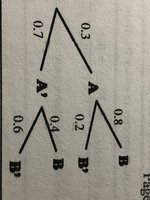Probability tree diagram
- Thread starter Lanadoski
- Start date
Dr.Peterson
Elite Member
- Joined
- Nov 12, 2017
- Messages
- 16,822
I imagine you mean P(B). In math, B and b are not typically the same thing.
Can you tell me what P(A and B) and P(A' and B) are?
Can you see a way to use those to find P(B)?
Can you tell me what P(A and B) and P(A' and B) are?
Can you see a way to use those to find P(B)?
HallsofIvy
Elite Member
- Joined
- Jan 27, 2012
- Messages
- 7,763
Yes, that is correct so far. The point of asking about "A and B" and "A' and B" is that there are two different ways to get to B- by going through A or by going through A'. The probability of getting to A is 0.3. Once you are there the probability of getting to B is 0.8. The probability of both is (0.3)(0.8)= 0.24. Similarly the probability of going to A' is 0.7 and, once you are there, the probability of going on to B is 0.4 so the probability of "A' and B" is (0.7)(0.4)= 0.28.
That is, P(X and Y)= P(X)P(Y). To finish the problem you need to know that P(X or Y)= P(X)+ P(Y). To get to B you can go through "A and B" or "A' and B".
That is, P(X and Y)= P(X)P(Y). To finish the problem you need to know that P(X or Y)= P(X)+ P(Y). To get to B you can go through "A and B" or "A' and B".
Dr.Peterson
Elite Member
- Joined
- Nov 12, 2017
- Messages
- 16,822
No, I don't think you understand. There is one answer.
Suppose you carried out this process 100 times. You've found that 24% of the time you get A and then B, and 28% of the time you get A' and then B. All of those times you ended up with B. So what is the probability of getting B? The answer will be one number, and it's very easy to get.
Suppose you carried out this process 100 times. You've found that 24% of the time you get A and then B, and 28% of the time you get A' and then B. All of those times you ended up with B. So what is the probability of getting B? The answer will be one number, and it's very easy to get.
Dr.Peterson
Elite Member
- Joined
- Nov 12, 2017
- Messages
- 16,822
Yes, 0.24 + 0.28 = 0.52.
You can add these because they are mutually exclusive cases.
In general, [MATH]P(B) = P((A\cap B)\cup(A'\cap B)) = P(A\cap B)+P(A'\cap B)[/MATH].
You can add these because they are mutually exclusive cases.
In general, [MATH]P(B) = P((A\cap B)\cup(A'\cap B)) = P(A\cap B)+P(A'\cap B)[/MATH].

